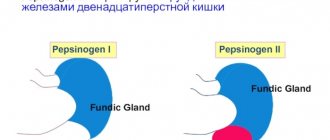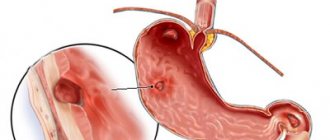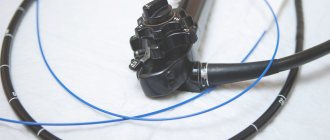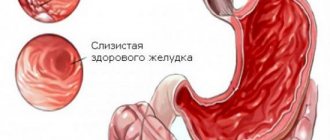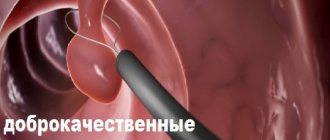Very often, patients come to the appointment who, due to pain in the upper abdomen, heaviness in the epigastric region after eating, and belching, have undergone gastroduodenoscopy and made a conclusion, based on which the doctor has diagnosed “atrophic gastritis.” A person is worried about what to do and whether this gastritis can turn into stomach cancer?
Today we will try to answer the question of what methods will help confirm the presence of atrophic gastritis and how to treat such patients.
Among stomach diseases, the most common diagnosis made by practitioners is “chronic gastritis.”
Chronic gastritis occupies a central place among stomach diseases and is the most common disease of the gastrointestinal tract. It is believed that a third of the adult population suffers from chronic gastritis, but only 10-15% consult a doctor. It is important that chronic gastritis precedes or accompanies diseases of the stomach that are serious in course and prognosis - peptic ulcers, stomach cancer, as well as nearby organs of the digestive system.
Atrophic gastritis - what is it?
What do we mean by atrophic gastritis? It is based on atrophic processes in the gastric mucosa, inflammatory and dystrophic processes that lead to functional failure of the mucosa. Atrophy of the glands of the gastric mucosa consists of a decrease in the number of cells that produce enzymes (pepsins) and parietal cells that secrete hydrochloric acid, and cells that produce Castle factor.
Anatomy of the stomach
Conventionally, there are several sections in the stomach:
- the cardiac section is the most initial one, where food comes from the esophagus,
- fundus - the uppermost dome-shaped part of the stomach, located at the very top of the stomach and where there is always some air,
- the body of the stomach (fundus), where enzymes and hydrochloric acid are produced and food is located during digestion,
- the outlet section or pyloric section of the stomach (antrum), which ends with the pyloric sphincter, which limits the cavity of the stomach and separates it from the duodenum.
Atrophy of stomach cells can affect all sections of the stomach, and then we are talking about total damage to the organ or affect specific sections - fundus (damage to the body of the stomach), antrum (outlet section of the stomach), or selectively affect part of the cells of the stomach. The clinical manifestations of atrophy in different parts of the stomach will be different.
It is known that the stomach is a hollow organ where food enters from the oral cavity and where gastric digestion of food occurs: food deposition, mechanical and chemical processing of food and its evacuation from the stomach into the intestinal tract.
Cytology of the stomach
In the mucosa of each section there are various cells responsible for the digestion of food and participation in hematopoiesis:
- parietal (or parietal) and main cells of the body of the stomach, which produce hydrochloric acid,
- pepsinogens, which under the influence of hydrochloric acid are converted into the active enzyme pepsin, which digests food proteins,
- chymosin and lipase, which digest milk,
- Castle factor (gastromucoprotein), which is responsible for the participation of the stomach in hematopoiesis and vitamin B12 metabolism. Castle factor binds to vitamin B12 in protein foods in the presence of calcium and transports vitamin B12 to the intestines, where it is absorbed into the body. With a lack of production of Castle factor, B12-deficiency anemia develops (decreased blood hemoglobin).
Additional flocculi of the gastric mucosa form mucus in almost all parts of the stomach. This mucus performs a protective function against bile, medications that the patient takes, and hydrochloric acid.
In the outlet section of the stomach there are endocrine cells - G cells, which produce a stimulator for the formation of pepsinogens, hydrochloric acid, and are responsible for the state of the motor function of the stomach.
Atrophic gastritis - causes of development
The most common cause of atrophic gastritis at present is considered to be Helicobacter pylori infection. Superficial gastritis develops in the stomach and, with prolonged infection, becomes atrophic.
Stomach infection is associated with damage to the antrum of the stomach in the form of limited or total damage to this department - atrophic gastritis of the antrum and body of the stomach. The development of atrophic processes in the stomach can be the result of age-related changes in the mucosa, genetic characteristics caused by hypo- or atrophy of the gastric mucosa, drug-induced damage to the stomach, or long-term use of antisecretory drugs (PPIs).
Autoimmune atrophic gastritis, when the body begins to produce antibodies against its cells in the gastric mucosa, is quite rare.
How to confirm the diagnosis of “atrophic gastritis”
The diagnosis of chronic atrophic gastritis is morphological . If an endoscopic examination is carried out, then if atrophic processes in the stomach are suspected, biopsies of the gastric mucosa should be taken and a histological interpretation of the changes in it given.
The morphological diagnosis should take into account: damage to the stomach, the condition of the glands, the severity and depth of inflammation and changes in the mucosa (metaplasia, dysplasia). The clinical diagnosis of “chronic atrophic gastritis” without morphological confirmation does not make sense.
The most accurate diagnostic method is endoscopic examination with biopsy . However, due to the uneven distribution of atrophic processes in the gastric mucosa, histological studies can give false negative results. In addition, biopsy is an expensive and time-consuming method and cannot be performed on every patient, and endoscopic examination itself is a seriously invasive method of examination.
Currently, there is an alternative to biopsy of the gastric mucosa - a screening method of research called “serum biopsy”, which can objectively reflect the functional state of the gastric mucosa and its morphological basis using blood serum samples.
Serum biopsy or Gastropanel (or test panel ) provides a simple and reliable way to obtain great information about the structure and function of the gastric mucosa, with great sensitivity and specificity to identify patients with atrophic gastritis and those who need further examination - endoscopic examination of the stomach. If the test panel reveals atrophic gastritis, then endoscopic examination is mandatory with oncological alertness.
How is Gastropanel performed?
Blood sampling to determine markers of atrophic gastritis is carried out in the morning on an empty stomach and 20 minutes after a protein breakfast. Blood is collected into serum tubes, which are centrifuged for analysis.
Blood serum analysis determines markers of chronic atrophic gastritis. Markers of atrophy of the mucous membrane of the fundic and antral parts of the stomach are:
- Pepsinogen I, Pepsinogen II and their ratio,
- Gastrin-17 and Gastrin-17 stimulated after a protein breakfast,
- determination of antibodies to Helicobacter pylori Ig G.
The tests are based on enzyme immunoassay technology.
Besides,
- Antibodies to parietal cells of the body of the stomach are determined in autoimmune atrophic gastritis with a high risk of disorders associated with vitamin B12 deficiency, for which the level of vitamin B12 is determined.
- Homocysteine is identified as a risk factor for vascular and thromboembolic diseases.
- To clarify Helicobacter pylori infection, an additional test of the acute phase of infection is performed, Ig A and IgM antibodies are determined.
Are there risk factors?
Experts consider the factors contributing to the hyperplastic course of atrophic gastritis to be the presence of a person’s food allergies (40% of cases in children are associated with gluten intolerance - celiac disease), vitamin deficiency, hyperglycemia in diabetes mellitus and kidney diseases accompanied by renal failure.
It has been established that long-term use in the treatment of gastritis of drugs that block the production of hydrochloric acid (a group of proton pump inhibitors, Omeprazole and analogs) leads to a significant increase in the risk of excessive activation of polyps in the areas of the gastric pits and main glands.
A few words about serum markers
We have a diagnostic algorithm for identifying stomach diseases, which is recommended for all patients who have pain or discomfort in the upper abdomen.
Pepsinogens
There are seven isoforms of pepsin precursors, five of which are designated as group Pepsinogen I of the main cells of the stomach body and Pepsinogen II, uniformly secreted by the glands of the entire stomach and duodenum. Pepsinogens formed in the stomach are absorbed into the blood and determination of their serum level is a generally accepted marker of atrophic gastritis “serological biopsy”.
A decrease in the level of Pepsinogen I indicates the severity of atrophic gastritis of the body of the stomach, and since the activation of Pepsinogen I into active pepsin occurs with the participation of hydrochloric acid, then the level of Pepsinogen I can roughly represent the level of stomach acidity. Pepsinogen II is produced in all parts of the stomach and in the duodenum. As the severity of atrophy increases, the ratio of serum levels of Pepsinogen I and Pepsinogen II decreases, which indicates the severity of atrophy and the spread of the process.
Gastrin
Gastrin-17, produced in the outlet section of the stomach after stimulation of cells by various factors (stomach distension, protein foods). In case of atrophy of the gastric antral mucosa, the secretion of Gastrin-17 decreases. To assess the presence and severity of the atrophic process in the stomach, it is necessary to conduct a protein stimulation test, the decrease of which shows the severity of atrophy; in the case of atrophy of the mucous membrane of the antrum of the stomach, the secretion of Gastrin-17 is proportionally reduced. In patients with severe atrophic gastritis in the antrum of the stomach, the risk of developing stomach cancer is 90 times higher than in people with normal gastric mucosa.
Homocysteine
Homocysteine is an early marker of cellular functional deficiency of B12, B6, folic acid due to the development of atrophic gastritis and other reasons - age, smoking, Helicobacter pylori infection, etc. With atrophic gastritis, the level of homocysteine increases in the blood and becomes toxic to the body. When donating blood for homocysteine, you should avoid protein foods, vitamins, and hormonal contraceptives 1 day before the test. This test can be an addition to the Gastropanel or an independent test for other diseases.
Principles of a therapeutic diet
The basis of the diet for atrophic gastritis is Diet No. 2. Products are divided into two categories - permitted and prohibited options. Ingredients from the second group can provoke an exacerbation of the inflammatory process. Failure to comply with the diet will reduce the tendency to recovery and the effectiveness of drug therapy.
With atrophic gastritis, it is important to follow a strict diet to improve the digestion process.
Authorized Products
For atrophic-type gastritis, it is allowed to add foods to the menu that do not irritate the digestive system. To improve the process of their digestion and absorption, it is recommended to grind the ingredients as much as possible.
When preparing dishes, do not use hot spices, seasonings, or add excessive amounts of salt.
Authorized products:
- low-fat fish (pollock, pink salmon);
- dietary meat (turkey, chicken, rabbit, veal);
- fermented milk products with a reduced fat content;
- rolled oats, rice, semolina, buckwheat;
- potatoes, carrots, beets, pumpkin, cucumbers, tomatoes;
- cheese, cottage cheese with low fat content;
- steam omelette or boiled eggs;
- crackers, biscuits;
- marmalade, marshmallows, marshmallows;
- butter and vegetable oil;
- compotes, jelly;
- fresh juices;
- weak black and green tea.
Fully or partially limited products
With atrophic gastritis, it is strictly forbidden to include fatty, fried, pickled, salty, and spicy foods on the menu. You should not eat foods that contribute to excessive gas formation (legumes, mushrooms, vegetables containing coarse fiber). Heavy food will complicate the digestion process and cause disruption of bowel movements.
Prohibited products:
Products prohibited for gastritis: fatty meats and fish;- salo;
- sausages;
- whole milk;
- pearl barley, millet, barley;
- legumes;
- horseradish, mustard;
- ketchup, mayonnaise;
- hot sauces;
- baked goods;
- bread made from rye flour;
- carbonated drinks;
- coffee;
- alcohol.
Advantages of Gastropanel for diagnosing “atrophic gastritis”
Thus, Gastropanel allows you to answer the following questions:
- does the patient have atrophic gastritis, in which part of the stomach are the changes localized,
- assess the risk of developing stomach cancer and peptic ulcers,
- does the patient suffer from gastritis caused by Helicobacter pylori,
- identify autoimmune gastritis or atrophic gastritis with damage to the body of the stomach, which may determine the risk of developing vitamin B12 deficiency, which can be associated with many diseases (atherosclerosis, vascular damage to the brain and heart, depression, polyneuropathy, dementia, etc.)
What advantages of Gastropanel can be noted: it is a simple non-invasive serological test, high sensitivity, specificity, safety and convenience for the patient, quick results, and meets the principles of evidence-based medicine.
Symptoms
The more acidity is reduced, the more clearly the symptoms of gastritis with low acidity will appear:
- Signs of excessive bacterial growth include rumbling, loose stools, milk intolerance, and bloating. If gastritis is accompanied by frequent diarrhea, weight loss may occur and signs of mineral or vitamin deficiency may develop.
- Dystrophy - signs of deficiency of B vitamins, as well as C, E, D, protein deficiency (weight loss, “polished” or coated tongue with a thick white coating).
- Dyspepsia - loss of appetite, feeling of heaviness or fullness in the stomach, belching of rotten food, bad breath (cocosmia), unpleasant taste, nausea.
- Dull, aggravated after eating, without clear localization, aching pain that occurs due to stretching of the stomach.
- Development of anemia due to decreased absorption of iron and vitamin B12 (due to Castle factor).
Since inflammation of the stomach also affects other parts of the digestive system, hypoacid gastritis is often accompanied by diseases such as enterocolitis, cholecystitis, and pancreatitis.
What to do if you are diagnosed with atrophic gastritis
A few words about the principles of treatment of chronic atrophic gastritis. Treatment approaches are individual, it all depends on the severity of atrophic processes, the presence of Helicobacter, and vitamin B12 deficiency.
The problem will be dealt with by a doctor who will prescribe:
- treatment,
- repeated studies to monitor treatment,
- repeated consultations to assess the clinical manifestations of the disease and adjust treatment.
It is most difficult to eliminate autoimmune mechanisms of damage to the gastric mucosa; the question of prescribing hormonal drugs arises only when gastritis is accompanied by anemia. Helicobacter pylori eradication therapy has its own characteristics. First of all, the question arises about the acidity of gastric juice, and more often treatment is carried out without antisecretory drugs. The study of the acidity of gastric juice using the pH-metric method is now rarely carried out (usually daily monitoring in a hospital setting), but it is possible to orient the acidity according to the level of Pepsinogen I.
A high level of Pepsinogen and periodic heartburn in a patient may indicate preserved gastric secretion. In case of atrophic gastritis in a hypo or anacid state with damage to the body and outlet of the stomach, antisecretory drugs are excluded and Helicobacter pylori eradication is carried out with antibiotics. Effective eradication of infection improves processes in the gastric mucosa, and can be considered as a prevention of the development of gastric cancer.
Signs of the disease
Loss of appetite is the main symptom of gastritis.
The manifestation of symptoms of the disease depends on the degree of the atrophic process. Atrophic gastritis is divided according to intensity:
- Pronounced
- Moderately expressed
- Atrophic-hyperplastic
The main symptoms of the disease include:
- Heaviness in the stomach
- Dull pain in the abdomen
- Belching with a rotten smell
- Dry mouth
- Bitter taste in mouth
- Weight loss
- Loss of appetite
- Diarrhea and constipation alternately
- Smooth tongue with white coating
Due to a lack of vitamins and nutrients, the following symptoms are observed:
- Decreased vision
- Bleeding gums
- Brittle nails
- Hair loss
- Dry and pale skin
- Weakness, dizziness, chills after eating
- Purulent skin lesions
- Frequent colds
- Risk factors
In a healthy person, the mucous membrane represents a damage-resistant, durable defense of the stomach walls; this protection is much more powerful than that of skin cells, but under the influence of certain factors it is reduced. Factors causing weakening of the mucosa:
- Diseases of the gastrointestinal tract
- Weakened immune system
- Great physical activity
- Occupational hazard
- Overwork
- Stress
- Hereditary diseases
- Consequences of the disease
Atrophic gastritis provokes the development of a cancerous tumor; the lower the acidity of gastric juice, the higher the risk. The beginning of degeneration is difficult to determine; in the initial stages, cancer does not make itself known. Therefore, it is important to begin treatment of atrophic gastritis as early as possible, even at the stage of subatrophic gastritis. Severe atrophy of the stomach walls is recognized as a precancerous disease.
Nutrition for chronic atrophic gastritis
There are no strict dietary restrictions, but you need to know that some foods alkalize the stomach (mainly protein foods) and further reduce the acidity of gastric juice, and there are foods that stimulate it (vegetable and fruit juices, vegetables, fruits).
Most often, doctors prescribe diet 2, the purpose of which is to mechanically spare the gastric mucosa and preserve chemical irritants.
But medical experience shows that strict restrictions are not required. The necessary diet - eating in small portions with replacement therapy drugs allows for good gastric digestion, in which protein foods are also digested in the stomach.
What are hyperplastic growths formed from?
The method of examining the stomach using a fibrogastroscope and studying biopsies from different areas of the affected tissue made it possible to identify microscopic changes accompanying hyperplastic cell proliferation.
In areas of inflammation, the process of cell mitosis (division) changes. As a result, the order of arrangement of the excess number is disrupted, the folded structure of the gastric mucosa changes, thickened folds (rigid) appear, which cannot stretch and increase the volume of the stomach when food arrives.
In the submucosal layer (submucosal), instead of elastin fibers, dense nodular formations are formed, varying in size and crowding. Structural abnormalities are located in different parts of the stomach (in the body, cardia, antrum). Against the background of epithelial proliferation, glandular cells that produce gastric juice are suppressed and destroyed, and the surrounding mucosa atrophies.
During histological examination, areas of clutter and destruction of the epithelium are identified
Atrophic gastritis - treatment
Replacement therapy
Replacement therapy includes the use of hydrochloric acid preparations and gastric juice enzymes:
- Natural gastric juice is a preparation of animal origin, the composition corresponding to human gastric juice, contains hydrochloric acid and enzymes. Use 1-2 tablespoons (15 - 30 ml) during meals or after meals 2-3 times a day.
- Acidin-pepsin , containing betaine hydrochloride, which is hydrolyzed in the stomach to release free hydrochloric acid and the enzyme pepsin. Before use, tablets (500 mg) are dissolved in 50-100 ml of water and taken with meals. These medications are administered through a straw.
- Abomin - the drug contains the sum of proteolytic enzymes of the stomach and is obtained from the gastric mucosa of calves and lambs. Use 1 tablet (0.2 g each containing 50,000 units in 1 tablet) 2 - 3 times a day with meals for 1 - 3 months.
Stimulant therapy
Some drugs that stimulate the secretion of gastric juice:
- Mineral water (Essentuki N17, Narzan) is used warm 15-20 minutes before meals, the course is 2-3 weeks, twice a year.
- Rosehip decoction , cabbage, tomato, carrot, lemon juice, 50 ml each, diluted with boiled water 1:1 before meals, alternate.
- Medicinal mixtures: plantain, St. John's wort, wormwood, thyme in equal proportions.
- Plantaglucide is widely used - granules of plantain leaves to prepare a suspension, for which take 1/1 -1 teaspoon (½-1 g) per ¼ glass of warm water and apply 30 minutes before meals 2-3 times a day, course of treatment 3- 4 weeks, for preventive treatment 1-2 months. Plantaglucide activates gastric secretion, has an enveloping, regenerative, anti-inflammatory and antispasmodic effect.
- Collection of herbalist Mikhalchenko S.I.:
Ingredients: angelica, yarrow, dandelion, birch, trifoliate, plantain, caraway, burnet, licorice, fumifera, calendula, chamomile. Application: pour 1 dessert spoon of the mixture into 500 ml of boiling water, leave in a thermos by volume overnight, strain. Take 150 ml 3 times a day an hour before meals. Before use, warm up by diluting with hot water. Keep refrigerated. Reception: 10 days admission - 2 days break, 3-4 months.
During the period of relative remission of atrophic gastritis, the main drugs are replacement and stimulating therapy, which affect the secretory insufficiency of the stomach.

